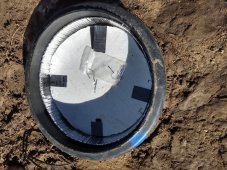Per subject line.
I have a small wireless network in a remote area which uses solar power at all the sites. I have been using AGM batteries since I set things up in 2008, replacing them as they reach EOL.
Recently, the AGM at one of the sites starting showing its age, so I thought this might be a chance to evolve to LiFePO4 and try it out. The site isn't important enough that if I make mistakes during the learning experience and stuff goes down for awhile somebody will complain. It only hosts an ultrasonic water level indicator for a tank there and provides a wireless relay for data to one cabin which won't see any occupancy until next Spring.
I spent quite a bit of time here and on other sites educating myself on Lithium before pulling the trigger on a Weize 12V/100aH battery last October. It would replace an old Interstate DCM0090 90Ah AGM. Ran it at my shop for a couple months off a 250W panel and an EPEVER CC programmed per Weize's instructions. I was pretty impressed.
Took the battery up to the site and installed it over Thanksgiving week. We see snow and single digit low temps there so I went with the beehive heating pad and 12V thermostat from Amazon route. This worked well - keeping the battery at 40-42 deg. The battery was reaching "float" (I know that's not really how LiFePO4 works, but it's what I call it) almost every day. The load is a constant 15W.
At the end of December, we had a weather event that resulted in a week of snow and little to no sun. The Weize kept powering through for 6 days when the BMS finally cut it off due to low voltage. We have not had that many days of no sun since I got involved there in 2004.
Because of that the heater stopped working, so we had to do a "boots on the ground" visit to jump the battery with 12V and reset the BMS after warming it above 32.
My question is this:
How do you configure a remote Li install that can restart itself if LVD cuts off the heater and the battery temp goes below freezing? I gave some thought to running the heater directly off the panel array using a DC-DC converter, but that wouldn't run at night.
I know the obvious solution is to install so much battery capacity that this will never happen. That gets expensive.
Are there other ways to approach this? I really would like to make the move to Li, but the result needs to be as bomb-proof as an AGM install. Having a LVD event with those was annoying, but as soon as the snow melted off the panel array, they would self-restore. Snowshoeing over a mile to a hilltop site to kick-start a Li battery that has been BMS'd does NOT appeal to me.
Thanks for any advice you all can give.
I have a small wireless network in a remote area which uses solar power at all the sites. I have been using AGM batteries since I set things up in 2008, replacing them as they reach EOL.
Recently, the AGM at one of the sites starting showing its age, so I thought this might be a chance to evolve to LiFePO4 and try it out. The site isn't important enough that if I make mistakes during the learning experience and stuff goes down for awhile somebody will complain. It only hosts an ultrasonic water level indicator for a tank there and provides a wireless relay for data to one cabin which won't see any occupancy until next Spring.
I spent quite a bit of time here and on other sites educating myself on Lithium before pulling the trigger on a Weize 12V/100aH battery last October. It would replace an old Interstate DCM0090 90Ah AGM. Ran it at my shop for a couple months off a 250W panel and an EPEVER CC programmed per Weize's instructions. I was pretty impressed.
Took the battery up to the site and installed it over Thanksgiving week. We see snow and single digit low temps there so I went with the beehive heating pad and 12V thermostat from Amazon route. This worked well - keeping the battery at 40-42 deg. The battery was reaching "float" (I know that's not really how LiFePO4 works, but it's what I call it) almost every day. The load is a constant 15W.
At the end of December, we had a weather event that resulted in a week of snow and little to no sun. The Weize kept powering through for 6 days when the BMS finally cut it off due to low voltage. We have not had that many days of no sun since I got involved there in 2004.
Because of that the heater stopped working, so we had to do a "boots on the ground" visit to jump the battery with 12V and reset the BMS after warming it above 32.
My question is this:
How do you configure a remote Li install that can restart itself if LVD cuts off the heater and the battery temp goes below freezing? I gave some thought to running the heater directly off the panel array using a DC-DC converter, but that wouldn't run at night.
I know the obvious solution is to install so much battery capacity that this will never happen. That gets expensive.
Are there other ways to approach this? I really would like to make the move to Li, but the result needs to be as bomb-proof as an AGM install. Having a LVD event with those was annoying, but as soon as the snow melted off the panel array, they would self-restore. Snowshoeing over a mile to a hilltop site to kick-start a Li battery that has been BMS'd does NOT appeal to me.
Thanks for any advice you all can give.




